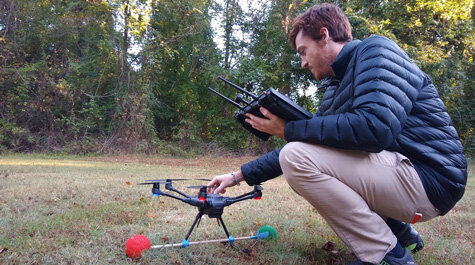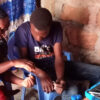The Delmarva Peninsula, which includes Virginia’s Eastern Shore, is the avian version of a southbound interstate during the fall migration of raptors and songbirds.
“It’s a geographic area that sees an incredibly high abundance of birds moving through,” Timothy Boycott explains. “And these birds are moving southward along the Atlantic migratory flyway, headed as far south as the very tip of South America in some cases.”
Boycott is part of a group that took advantage of the heavy migratory traffic to field test technology designed to prevent avian deaths by steering them away from man-made structures. The system, called Acoustic Lighthouse, projects engineered noise to alert migrating birds that there is danger ahead.
The group recently published results of a practical study of the technology at a pair of communications towers on the Delmarva Peninsula during fall migration. Boycott is a co-inventor of the technology and the lead author on the PLOS One paper “Field testing an ‘acoustic lighthouse’: Combined acoustic and visual cues provide a multimodal solution that reduces avian collision risk with tall human-made structures.”
Boycott is a recent graduate of the M.S. program in William & Mary’s Department of Biology. His co-authors include Acoustic Lighthouse technology co-inventor John Swaddle, faculty director of William & Mary’s Institute for Integrative Conservation and a professor in the bio department. Other co-authors are Brandon Jackson of Longwood University and a William & Mary undergraduate, Sally Mullis ’21.
Boycott explained that if you add up the number of birds that come to grief by smacking into human-made structures, the total reaches into the billions each year. It’s a matter of increasing concern as more and more wind turbines are proposed, planned and constructed.
“Birds migrate along wind streams, and we want to place wind turbines in those areas because we want to harness the energy from those same wind streams,” Boycott said. “It’s an area of high potential conflict between migrating birds and human development.”
Swaddle explains the idea behind Acoustic Lighthouse is to get the birds to look where they’re going—the anatomical position of a bird in flight puts the focus more down than ahead.
The acoustics in the lighthouse come in the form of bands of noise that can’t be confused for other sounds. The collaborators set up speakers at the base of communications towers at two locations on Virginia’s Eastern Shore. They aimed the speakers upward, to intercept the southbound avian traffic.
“We tested out two different types of sound,” Boycott said. “They were both broad-spectrum, a kind of staticky, hissy type sound.”
He said that they tried the hissy-type sound in two frequencies: 4-6 kHz and 6-8 kHz. Boycott explained that they selected the 4-6 kHz range to match the known hearing range of many birds, while the 6-8 kHz range was chosen to stand out among ambient noise, such as wave action and traffic. For control, they had sessions with no hissy sound playing.
They collected data for three hours a day over six sampling days, recording the bird behavior on video, with cameras aimed in three zones: approach, passing and flying away from the towers.
“We reconstructed their flight paths and were able to ask all sorts of things about the birds’ flight behavior,” Boycott said. “How fast were they going? How close did they get to the towers? The angle that they flew away from the towers.”
As they analyzed the footage from three sets of videos—4-6 kHz, 6-8 kHz and control—some patterns emerged. For one thing, both sound frequencies were effective when compared to control, but one was better than others.
“We saw that during the 4-6 kHz, lower frequency sound range, the birds slowed down the most,” Boycott said. “They stayed farther away from the towers and they angled their flight trajectories away from the towers more.”
The group is interpreting the observed flight behaviors in terms of the degree of collision risk they represent. For instance, if a bird slows down or veers, it makes sense that there is a corresponding reduction in collision risk.
Swaddle and Boycott said that at this stage of testing, videotaping and counting how many birds veer off is preferable to the standard methodology for a couple of reasons.
“Most studies on collision collect mortality data,” Boycott explained. “They go to the bases of these structures and count the number of dead birds.”
He pointed out that even though structure collisions are a massive problem collectively, individual collisions are few and far between. Studies that rely on collection of dead birds take months and months—sometimes years—to gather sufficient data.
“And one of the problems with carcass surveys is that you miss a lot,” Swaddle added. “If a bird strikes a tower and falls, it could be scavenged. Or it might make it 50 yards or so before it hits the ground. In either case, you’ll never find it.”
Another major benefit of the video methodology is that its real-time nature allows the researchers to tally potential birds saved, as opposed to counting birds lost. Both Swaddle and Boycott believe that including a carcass survey with their video methodology could provide additional insights into the effectiveness of Acoustic Lighthouse.
“Future studies would be really important to see how those differences in flight behavior actually translate to mortality on the ground,” Boycott said.
Reducing bird-related tragedy through understanding bird behavior
More information:
Timothy J. Boycott et al. Field testing an “acoustic lighthouse”: Combined acoustic and visual cues provide a multimodal solution that reduces avian collision risk with tall human-made structures, PLOS ONE (2021). DOI: 10.1371/journal.pone.0249826
Provided by
The College of William & Mary
Citation:
Acoustic Lighthouse field tests: Engineered noise to reduce bird-structure collisions (2021, May 11)
retrieved 11 May 2021
from https://techxplore.com/news/2021-05-acoustic-lighthouse-field-noise-bird-structure.html
This document is subject to copyright. Apart from any fair dealing for the purpose of private study or research, no
part may be reproduced without the written permission. The content is provided for information purposes only.



